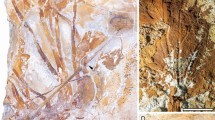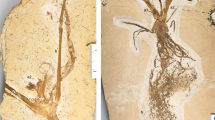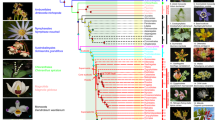Abstract
The current molecular systematics of angiosperms1 recognizes the basal angiosperms and five major angiosperm lineages: the Chloranthaceae, the magnoliids, the monocots, Ceratophyllum and the eudicots, which consist of the basal eudicots and the core eudicots2. The eudicots form the majority of the angiosperms in the world today. The flowering plants are of exceptional evolutionary interest because of their diversity of over 250,000 species and their abundance as the dominant vegetation in most terrestrial ecosystems, but little is known of their very early history. In this report we document an early presence of eudicots during the Early Cretaceous Period. Diagnostic characters of the eudicot fossil Leefructus gen. nov. include simple and deeply trilobate leaves clustered at the nodes in threes or fours, basal palinactinodromous primary venation, pinnate secondary venation, and a long axillary reproductive axis terminating in a flattened receptacle bearing five long, narrow pseudo-syncarpous carpels. These morphological characters suggest that its affinities are with the Ranunculaceae, a basal eudicot family. The fossil co-occurs with Archaefructus sinensis3 and Hyrcantha decussata4 whereas Archaefructus liaoningensis5 comes from more ancient sediments. Multiple radiometric dates of the Lower Cretaceous Yixian Formation place the bed yielding this fossil at 122.6–125.8 million years old6,7,8. The earliest fossil records of eudicots are 127 to 125 million years old, on the basis of pollen9,10. Thus, Leefructus gen. nov. suggests that the basal eudicots were already present and diverse by the latest Barremian and earliest Aptian.
This is a preview of subscription content, access via your institution
Access options
Subscribe to this journal
Receive 51 print issues and online access
$199.00 per year
only $3.90 per issue
Buy this article
- Purchase on Springer Link
- Instant access to full article PDF
Prices may be subject to local taxes which are calculated during checkout





Similar content being viewed by others
References
Qiu, Y.-L. et al. The earliest angiosperms: evidence from mitochondrial, plastid and nuclear genomes. Nature 402, 404–407 (1999)
Moore, M. J. et al. Using plastid genome-scale data to resolve enigmatic relationships among basal angiosperms. Proc. Natl Acad. Sci. USA 104, 19363–19368 (2007)
Sun, G. et al. Archaefructaceae, a new basal angiosperm family. Science 296, 899–904 (2002)
Dilcher, D. L. et al. An early infructescence Hyrcantha decussata (comb. nov.) from the Yixian Formation in northeastern China. Proc. Natl Acad. Sci. USA 104, 9370–9374 (2007)
Sun, G. et al. In search of the first flower: a Jurassic angiosperm, Archaefructus, from Northeast China. Science 282, 1692–1695 (1998)
Zhang, H. et al. U-Pb isotopic age of the Lower Yixian Formation in Lingyuan of western Liaoning and its significance. Geol. Rev. 52, 63–71 (2006)
Swisher, C. C. et al. Cretaceous age for the feathered dinosaurs of Liaoning, China. Nature 400, 58–61 (1999)
Meng, F. X., Gao, S. & Liu, X. M. U-Pb zircon geochronology and geochemistry of volcanic rocks of the Yixian Formation in the Lingyuan area, western Liaoning, China. Geol. Bull. China 27, 364–373 (2008)
Doyle, J. A. & Hotton, C. L. in Pollen and Spores: Patterns of Diversification (eds Blackmore, S. & Barnes, S. H. ) 169–195 (Clarendon Press, 1991)
Hughes, N. F. The Enigma of Angiosperm Origins (Cambridge University Press, 1994)
Crepet, W. L., Nixon, K. C. & Gandolfo, M. A. Fossil evidence and phylogeny: the age of major angiosperm clades based on mesofossil and macrofossil evidence from Cretaceous deposits. Am. J. Bot. 91, 1666–1682 (2004)
Anderson, C. L., Bremer, K. & Friis, E. M. Dating phylogenetically basal eudicots using rbcL sequences and multiple fossil reference points. Am. J. Bot. 92, 1737–1748 (2005)
Taylor, T. N., Taylor, E. L. & Krings, M. Paleobotany: The Biology and Evolution of Fossil Plants (Elsevier Science and Technology, 2008)
Chang, M. M. Jehol Biota [in Chinese] (Shanghai Sci. Tech. Press, 2001)
Ren, D. et al. Flower-associated brachycera flies as fossil evidence for Jurassic angiosperm origins. Science 280, 85–88 (1998)
Zhou, Z., Barrett, P. M. & Hilton, J. An exceptionally preserved Lower Cretaceous ecosystem. Nature 421, 807–814 (2003)
Peng, Y. D. et al. 40Ar/39Ar and K-Ar dating of the Yixian Formation volcanic rocks, western Liaoning Province, China. Geochimica 32, 427–435 (2003)
Angiosperm Phylogeny Group An update of the Angiosperm Phylogeny Group classification for the orders and families of flowering plants: APG III. Bot. J. Linn. Soc. 161, 105–121 (2009)
Barrett, P. M. Evolutionary consequences of dating the Yixian Formation. Trends Ecol. Evol. 15, 99–103 (2000)
Chang, S.-C. et al. High-precision 40Ar/39Ar age for the Jehol Biota. Palaeogeogr. Palaeoclimatol. Palaeoecol. 280, 94–104 (2009)
Swisher, C. C. et al. Further support for a Cretaceous age for the feathered-dinosaur beds of Liaoning, China: New dating of the Yixian and Tuchengzi Formations. Chin. Sci. Bull. 47, 136–139 (2002)
Wang, S. S. et al. Further discussion on the geological age of Sihetun vertebrate assemblage in western Liaoning, China: evidence from Ar-Ar dating. Acta Petrol. Sin. 7, 663–668 (2001)
Wang, W. et al. Phylogeny and classification of Ranunculales: evidence from four molecular loci and morphological data. Perspect. Plant Ecol. Evol. Syst. 11, 81–110 (2009)
Doyle, J. A. et al. Angiosperm pollen from the pre-Albian Lower Cretaceous of equatorial Africa. Bull. Centres Recherches Exploration-Production Elf-Aquitaine 1, 451–473 (1977)
Doyle, J. A. Cretaceous angiosperm pollen of the Atlantic Coastal Plain and its evolutionary significance. J. Arnold Arbor. 50, 1–35 (1969)
Leng, Q. & Friis, E. M. Sinocarpus decussates gen. et sp. nov., a new angiosperm with basally syncarpous fruits from the Yixian Formation of Northeast China. Plant Syst. Evol. 241, 77–88 (2003)
Wikström, N., Savolainen, V. & Chase, M. W. Evolution of the angiosperms: calibrating the family tree. Proc. R. Soc. Lond. 268, 2211–2220 (2001)
Bell, C. D., Soltis, D. E. & Soltis, P. S. The age of the angiosperms: a molecular timescale without a clock. Evolution 59, 1245–1258 (2005)
Bell, C. D., Soltis, D. E. & Soltis, P. S. The age and diversification of the angiosperms re-revisited. Am. J. Bot. 97, 1296–1303 (2010)
Smith, S. A., Beaulieu, J. M. & Donoghue, M. J. An uncorrelated relaxed-clock analysis suggests an earlier origin for flowering plants. Proc. Natl. Acad. Sci. USA 107, 5897–5902 (2010)
Acknowledgements
We acknowledge the support of the Key Lab of Evolution of Past Life and Environment in Northeast Asia, Ministry of Education, China, and Project “111” of China, NSFC project number 40842002, and the President Special Fund of Shenyang Normal University to carry out this research project during 2008–2009. Many thanks to S. M. Li and L. X. Wang for their help in collecting the fossil specimen. We thank Y. Duan, C. T. Li, Y. S. Liu, D. M .Jarzen, T. Lott, S. Trammel and W. Wang for their assistance in analysis, computer work, photography and artwork. We also thank P. and D. Soltis, K. Nixon, M. Moore and J. Doyle for suggestions.
Author information
Authors and Affiliations
Contributions
G.S. and D.L.D. designed the research plan. G.S., D.L.D., H.W. and Z.C. performed analysis. G.S., D.L.D. and H.W. wrote the manuscript. All authors discussed and commented on the manuscript.
Corresponding authors
Ethics declarations
Competing interests
The authors declare no competing financial interests.
Rights and permissions
About this article
Cite this article
Sun, G., Dilcher, D., Wang, H. et al. A eudicot from the Early Cretaceous of China. Nature 471, 625–628 (2011). https://doi.org/10.1038/nature09811
Received:
Accepted:
Published:
Issue Date:
DOI: https://doi.org/10.1038/nature09811
This article is cited by
-
A high-quality Buxus austro-yunnanensis (Buxales) genome provides new insights into karyotype evolution in early eudicots
BMC Biology (2022)
-
First evidence of ranunculids in Early Cretaceous tropics
Scientific Reports (2022)
-
Primotrapa gen. nov., an extinct transitional genus bridging the evolutionary gap between Lythraceae and Trapoideae, from the early Miocene of North China
BMC Evolutionary Biology (2020)
-
Macrofossil evidence unveiling evolution of male cones in Ephedraceae (Gnetidae)
BMC Evolutionary Biology (2018)
-
Multilocus phylogenetic reconstruction informing polyploid relationships of Aconitum subgenus Lycoctonum (Ranunculaceae) in China
Plant Systematics and Evolution (2017)
Comments
By submitting a comment you agree to abide by our Terms and Community Guidelines. If you find something abusive or that does not comply with our terms or guidelines please flag it as inappropriate.



